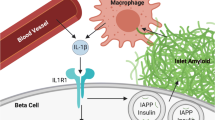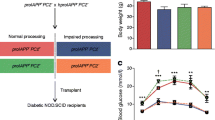Abstract
Background
Human, but not mouse, islet amyloid polypeptide (IAPP) is amyloidogenic. Transgenic mice overexpressing human IAPP in the β cells of the islets of Langerhans should be useful in identifying factors important for the deposition of IAPP as insoluble amyloid fibrils.
Materials and Methods
Transgenic mice expressing human IAPP were examined using several experimental models for the production of persistent hyperglycemia, as well as for the overstimulation and/or inhibition of β cell secretion. Obesity was induced by aurothioglucose. Persistent hyperglycemia was produced by long-term administration of glucocorticosteroids or by partial pancreatectomy. Inhibition of normal β cell exocytosis by diazoxide administration, with or without concurrent dexamethasone injections, was carried out to increase crinophagy of secretory granules. The human IAPP gene was also introduced into the db and ob mouse models for diabetes. Finally, isolated islets cultivated in vitro at high glucose concentration were also examined.
Results
No amyloid deposits were found in the pancreata of any of the animals, either by light microscopy after Congo red staining or by electron microscopy after immunogold labeling with antibodies specific for human IAPP. Aurothioglucose treatment resulted in increased numbers of granules in the β cell and the appearance of large lysosomal bodies without amyloid. However, islets from db and ob mice expressing human IAPP cultivated in vitro in the presence of glucocorticosteroid and/or growth hormone, were found to contain extracellular amyloid deposits reacting with antibodies to human IAPP.
Conclusions
Oversecretion of human IAPP or increased crinophagy are not sufficient for amyloid formation. This indicates that other factors must influence amyloid deposition; one such factor may be the local clearance of IAPP.







Similar content being viewed by others
References
Westermark P, Wernstedt C, Wilander E, Sletten K. (1986) A novel peptide in the calcitonin gene related peptide family as an amyloid fibril protein in the endocrine pancreas. Biochem. Biophys. Res. Commun. 140: 827–831.
Westermark P, Wernstedt C, Wilander E, Hayden DW, O’Brien TD, Johnson KH. (1987) Amyloid fibrils in human insulinomia and islets of Langerhans of the diabetic cat are derived from a neuropeptide-like protein also present in normal islet cells. Proc. Natl. Acad. Sci. U.S.A. 84: 3881–3885.
Cooper GJ, Willis AC, Clark A, Turner AC, Sim RB, Reid KBM. (1987) Purification and characterization of a peptide from amyloidrich pancreases of type 2 diabetic patients. Proc. Natl. Acad. Sci. U.S.A. 84: 8628–8632.
Johnson KH, O’Brien TD, Hayden DW, et al. (1988) Immunolocalization of islet amyloid polypeptide (IAPP) in pancreatic Beta cells by means of peroxidase-antiperoxidase (PAP) and protein A-gold techniques. Am. J. Pathol. 130: 1–8.
Clark A, Edwards CA, Ostle LR, et al. (1989) Localisation of islet amyloid peptide in lipofuscin bodies and secretory granules of human β-cells and in islets of type-2 diabetic subjects. Cell Tissue Res. 257: 179–185.
Lukinius A, Wilander E, Westermark GT, Engström U, Westermark P. (1989) Co-localization of islet amyloid polypeptide and insulin in the B cell secretory granules of the human pancreatic islets. Diabetologia 32: 240–244.
Nagamatsu S, Nishi M, Steiner DF. (1991) Biosynthesis of islet amyloid polypeptide-el-evated expression in mouse betαTC3 cells. J. Biol. Chem. 266: 13737–13741.
Sänke T, Bell GI, Sample C, Rubenstein AH, Steiner DF. (1988) An islet amyloid peptide is derived from an 89-amino acid precursor by proteolytic processing. J. Biol. Chem. 263: 17243–17246.
Betsholtz C, Svensson V, Rorsman F, et al. (1989) Islet amyloid polypeptide (IAPP): cDNA cloning and identification of an amyloidogenic region associated with species-specific occurrence of age-related diabetes mellitus. Exp. Cell Res. 183: 484–493.
Cooper GJS, Leighton B, Dimitriadis GD, et al. (1988) Amylin found in amyloid deposits in human type 2 diabetes mellitus may be a hormone that regulates glycogen metabolism in skeletal muscle. Proc. Natl. Acad. Sci. U.S.A. 85: 7763–7767.
Roden M, Liener K, Fürnsinn C, et al. (1992) Effects of islet amyloid polypeptide on hepatic insulin resistance and glucose production in the isolated perfused rat liver. Diabetologia 35: 116–120.
Westermark P, Johnson KH, O’Brien TD, Betsholtz C. (1992) Islet amyloid polypeptide—A novel controversy in diabetes research. Diabetologia 35: 297–303.
Beaumont K, Kenney MA, Young AA, Rank TJ. (1993) High affinity amylin binding sites in rat brain. Mol. Pharmacol. 44: 493–497.
Bhogal R, Purkiss P, Bloom SR. (1993) Molecular identification of binding sites for calcitonin gene-related peptide (CGRP) and islet amyloid polypeptide (IAPP) in mammalian lung—Species variation and binding of truncated CGRP and IAPP. Endocrinology 133: 2351–2361.
Bell ET. (1952) Hyalinization of the islets of Langerhans in diabetes mellitus. Diabetes 1: 341–344.
Bell ET. (1959) Hyalinization of the islets of Langerhans in nondiabetic individuals. Am. J. Pathol 35: 801–805.
Westermark P, Grimelius L. (1973) The pancreatic islet cells in insular amyloidosis in human diabetic and non-diabetic adults. Acta Path. Microbiol. Scand. A 81: 291–300.
Westermark P, Engström U, Johnson KH, Westermark GT, Betsholtz C. (1990) Islet amyloid polypeptide: pinpointing amino acid residues linked to amyloid fibril formation. Proc. Natl. Acad. Sci. U.S.A. 87: 5036–5040.
Betsholtz C, Christmanson L, Engström U, et al. (1990) Structure of cat islet amyloid polypeptide and identification of amino acid residues of potential significance for islet amyloid formation. Diabetes 39: 118–122.
Nishi M, Chan SJ, Nagamatsu S, Bell GI, Steiner DF. (1989) Conservation of the sequence of islet amyloid polypeptide in five mammals is consistent with its putative role as an islet hormone. Proc. Natl. Acad. Sci. U.S.A. 86: 5738–5742.
Jordan KC, O’Brien TD, Johnson KH. (1994) Sequence of raccoon IAPP supports importance of a specific structural motif in the development of pancreatic islet amyloidosis. Amyloid 1: 160–164.
Ohagi S, Nishi M, Bell Gl, Ensinck JW, Steiner DF. (1991) Sequences of islet amyloid polypeptide precursors of an old world monkey, the pig-tailed macaque (Macacanemestrina), and the dog (Canis-familiaris). Diabetologia 34: 555–558.
O’Brien TD, Westermark P, Johnson KH. (1990) Islet amyloid polypeptide and calcitonin gene-related peptide immunoreactivity in amyloid and tumor cells of canine pancreatic endocrine tumors. Vet. Pathol. 27: 194–198.
Nishi M, Bell Gl, Steiner DF. (1990) Sequence of a cDNA encoding Syrian hamster islet amyloid polypeptide precursor. Nucleic Acids Res. 18: 6726.
Fox N, Schrementi J, Nishi M, et al. (1993) Human islet amyloid polypeptide transgenic mice as a model of non-insulin-dependent diabetes mellitus (NIDDM). F.E.B.S. Lett. 323: 40–44.
Puchtier H, Sweat F, Levine M. (1962) On the binding of Congo red by amyloid. J. Histochem. Cytochem. 10: 355–364.
Drachman RH, Tepperman J. (1954) Aurothioglucose obesity in the mouse. Yale J. Biol. Med. 26: 394–408.
Creutzfeldt W, Creutzfeldt C, Frerichs H, Perings E, Sickinger K. (1969) The morphological substrate of the inhibition of insulin secretion by diazoxide. Horm. Metabol. Res. 1: 53–64.
Jansen GR, Hutchinson CF, Zanetti ME. (1967) Effects of diazoxide on glucose U-C-14 utilization in mice. Diabetes 16: 777–783.
Dubuc PU. (1976) The development of obesity, hyperinsulinemia and hyperglycemia in ob/ob mice. Metabolism 26: 1567–1574.
Coleman DL. (1978) Obesity and diabetes: Two mutant genes causing diabetes-obesity syndromes in mice. Diabetologia 14:141–148.
Lernmark Å, Nathans A, Steiner DF. (1976) Preparation and characterization of plasma membrane enriched fractions from rat pancreatic islets. J. Cell Biol. 71: 606–623.
Höppener JWM, Verbeek JS, de Koning EJP, et al. (1993) Chronic overproduction of islet amyloid polypeptide/amylin in transgenic mice: Lysosomal localization of human islet amyloid polypeptide and lack of marked hyperglycemia or hyperinsulinaemia. Diabetologia 36: 1258–1265.
Verchere CB, D’Alessio DA, Palmiter RD, Kahn SE. (1994) Transgenic mice overproducing islet amyloid polypeptide have increased insulin storage and secretion in vitro. Diabetologia 37: 725–728.
Westermark P. (1973) Fine structure of islets of Langerhans in insular amyloidosis. Virchows Arch. A 359: 1–18.
Cooper GJS, Day AJ, Willis AC, Roberts AN, Reid KBM, Leighton B. (1989) Amylin and the amylin gene: Structure, function and relationship to islet amyloid and to diabetes mellitus. Biochim. Biophys. Acta 1014: 247–258.
Westermark P. (1994) Amyloid and polypeptide hormones: What is their interrelationship? Amyloid 1: 47–60.
ShirahamaT, Cohen AS. (1975) Intralysoso-mal formation of amyloid fibrils. Am. J. Pathol. 81: 101–116.
Clark A. (1992) Islet amyloid—An enigma of type-2 diabetes. Diab. Metabol. Rev. 8: 117–132.
Coleman DL, Hummel KP. (1967) Studies with the mutation, diabetes, in the mouse. Diabetologia 3: 238–248.
Westermark P, Eizirik DL, Pipeleers DG, Hellerström C, Andersson A. (1995) Rapid deposition of amyloid in human islets transplanted into nude mice. Diabetologia 38: 543–554.
de Koning EPJ, Morris ER, Hofhuis FMA, et al. (1994) Intrα and extracellular amyloid fibrils are formed in cultured pancreatic islets of transgenic mice expressing human islet amyloid polypeptide. Proc. Natl. Acad. Sci. U.S.A. 91: 8467–8471.
Novials A, Sarri Y, Casamitjana R, Rivera F, Gomis R. (1993) Regulation of islet amyloid polypeptide in human pancreatic islets. Diabetes 42: 1514–1519.
Young ID, Ailles L, Narindrasorasak S, Tan R, Kisilevsky R. (1992) Localization of the basement membrane heparan sulfate proteoglycan in islet amyloid deposits in type-II diabetes-mellitus. Arch. Pathol. Lab. Med. 116: 951–954.
Wisniewski T, Frangione B. (1992) Apolipoprotein E: A pathological chaperone protein in patients with cerebral and systemic amyloid. Neurosci. Lett. 135: 235–238.
Lorenzo A, Razzaboni B, Weir GC, Yankner BA. (1994) Pancreatic islet cell toxicity of amylin associated with type-2 diabetes mellitus. Nature 368: 756–760.
Acknowledgments
This work was supported by the Swedish Medical Research Council (Project No. 5941), the Swedish Diabetes Association, the Novo-Nordisk Insulin Fund, National Institutes of Health Grants DK13914 and DK20595 and the Howard Hughes Medical Institute.
Author information
Authors and Affiliations
Rights and permissions
About this article
Cite this article
Westermark, G., Arora, M.B., Fox, N. et al. Amyloid Formation in Response to β Cell Stress Occurs In Vitro, but Not In Vivo, in Islets of Transgenic Mice Expressing Human Islet Amyloid Polypeptide. Mol Med 1, 542–553 (1995). https://doi.org/10.1007/BF03401591
Published:
Issue Date:
DOI: https://doi.org/10.1007/BF03401591




